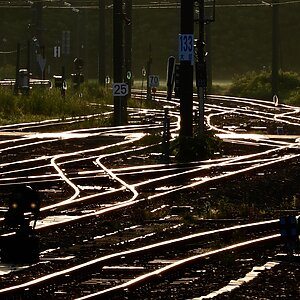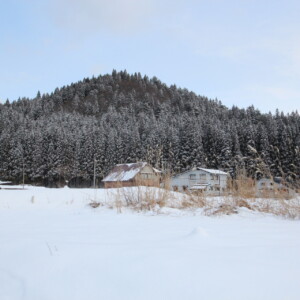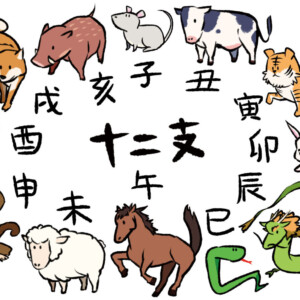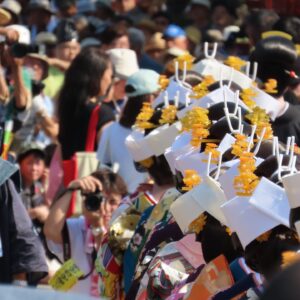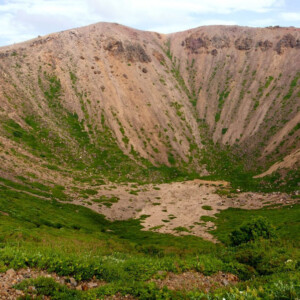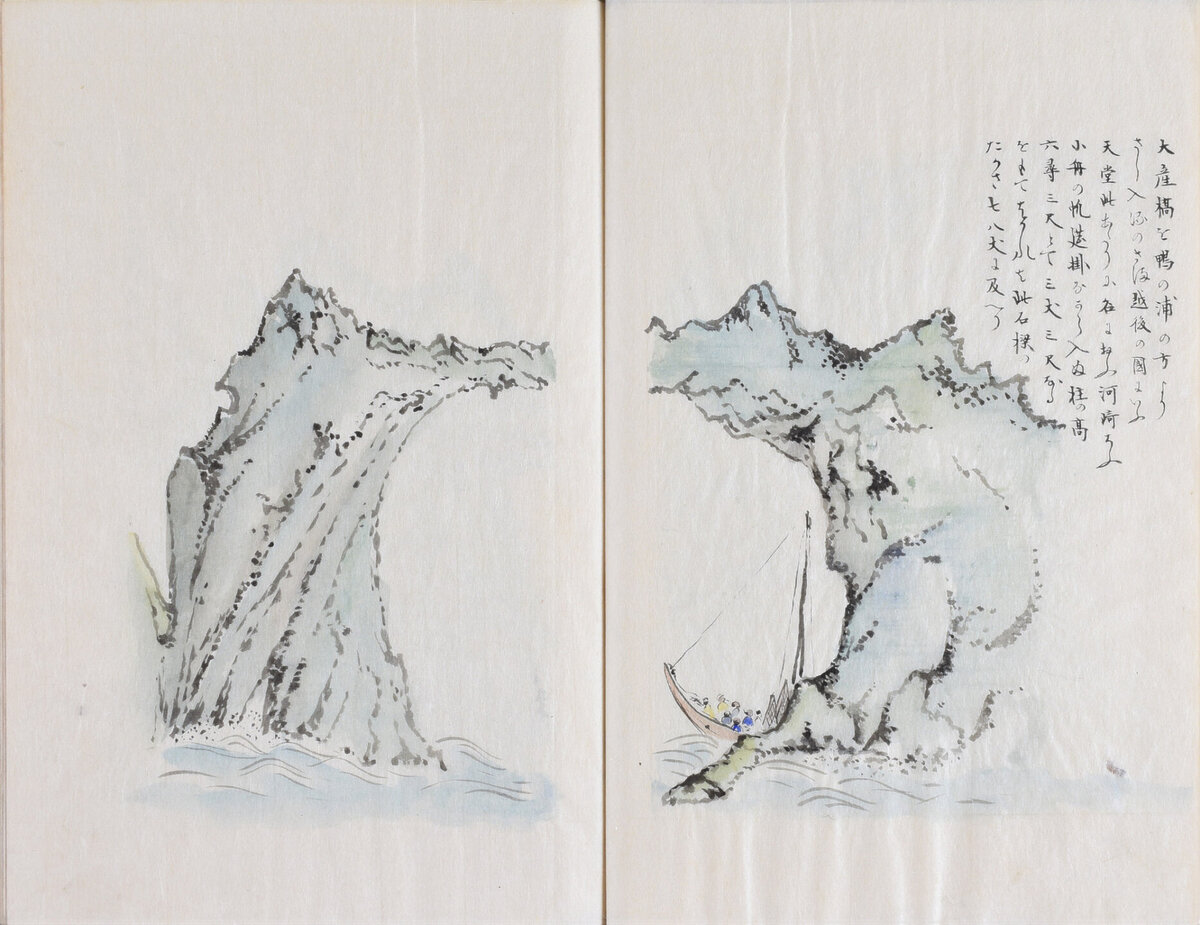
[Second Edition] Suga Masumi walked around the Oga Peninsula - Interested in the strange rocks along the coast [Akita Prefecture]
table of contents
- 1 The Oga Peninsula sightseeing begins again from Koiji Temple (Mayan Shrine), where the Namahage legend remains (``Oga no Harukaze'').
- 2 Enjoy the magnificent view of the west coast of the Oga Peninsula from Hachibodai
- 3 Strolling around Hatazaki (Nyudozaki), which was very lonely during the Edo period ("Suzukaze of Oga")
- 4 Wandering around the very crowded Toga Bay area
- 5 View the complex coastline and strangely shaped rocks of the southwest from a dugout canoe ("Oga no Shimakaze")
- 6 Be impressed by the strangely shaped rocks such as Kankane Cave and the Great Pier
- 7 On the Oga Peninsula where Masumi Sugae walked, there are 90 marker posts and information boards set up to help you take a stroll.
- 8 Link: Retracing the Oga Peninsula that Masumi Sugae walked (3 times in total)
the Oga Five Winds Masumi (1754-1829) during the Edo period he wrote about his travels around the Oga Peninsula, and contrasts the Edo period with the present day.
Oga Spring Wind ," which resumed his journey to the Oga Peninsula and traveled the north coast "Oga Suzukaze " which toured the west coast .
This article will be written with reference to manuscripts held by the Akita Prefectural Museum, the National Archives of Japan, the National Diet Library, and a modern translation published in 2000. Dates in the Edo period are the dates and times recorded by Masumi (old calendar) unless otherwise noted.
reference
- Akita Prefectural Museum Masumi Sugae Library (Manuscripts)
- URL: Akita Prefectural Museum Masumi Sugae Library
- National Diet Library Digital Collection Akita Series Special Collection No. 1 (Masumi Sugae Collection No. 1/Manuscript)
- URL: National Diet Library Digital Collection
- National Archives Masumi Travelogue (manuscript of 1898)
- URL: National Archives Masumi Travelogue
- Published by Heibonsha Masumi Sugae Travelogue 5 Edited and translated by Takeshi Uchida and Tsuneichi Miyamoto Published on August 9, 2000
- *Citations from Masumi Sugae's writings are based on ``Masumi Sugae Travelogue, Heibonsha Publishing, Edited and Translated by Takeshi Uchida and Tsuneichi Miyamoto.''
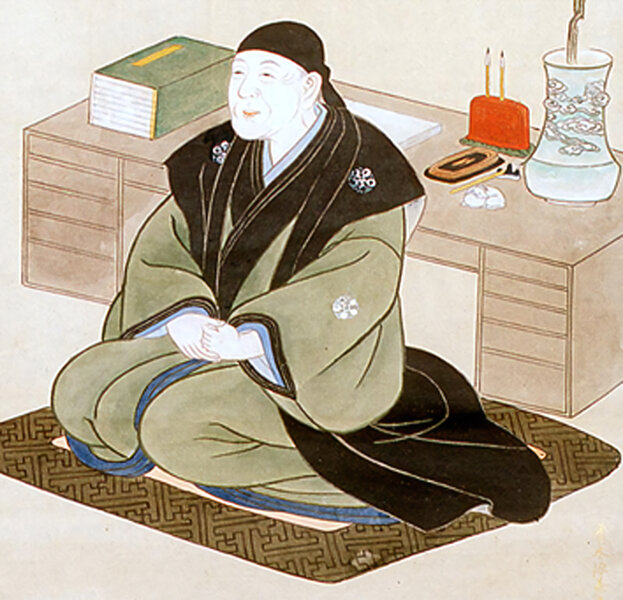
The Oga Peninsula sightseeing begins again from Koiji Temple (Mayan Shrine), where the Namahage legend remains (``Oga no Harukaze'').
Masumi spent the New Year in 1810 at Yachinaka (Okawayachiuchi, Gojome Town), near the Oga Peninsula , and headed
It will head north along the eastern coast of Hachirogata, head north to Noshiro, then south along the Sea of Japan, and on March 27th we will arrive at the Shin River (Sakawa/Noishi Shin River, Oga City), the entrance to the Oga Peninsula. However, Masumi, who has become unwell, finally leaves Shin River on April 7th, and arrives at the foot of Shinzan (567m) that day.
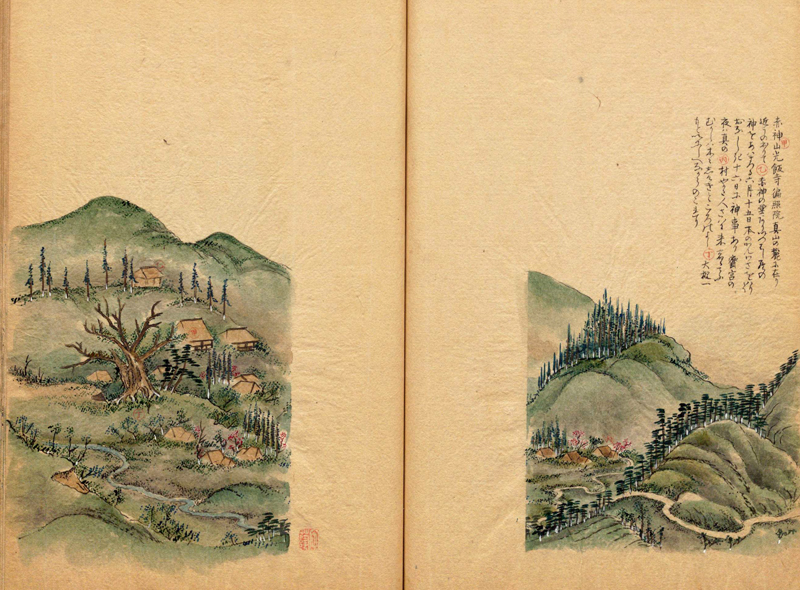
Like the head temple that towers next to it, Mayama is a sacred mountain with the legend of Akagami, and on the middle side is currently home to Shinzan Jinja (Kouboji Temple, until the Edo period) and Kitaura Mayama, Oga City.
Mayama Shrine is known for being deeply involved in Nama bald, and the shrine is home the Oga Mayama Traditional Museum and Nama bald Museum, and the Nama bald Festival is held every February.
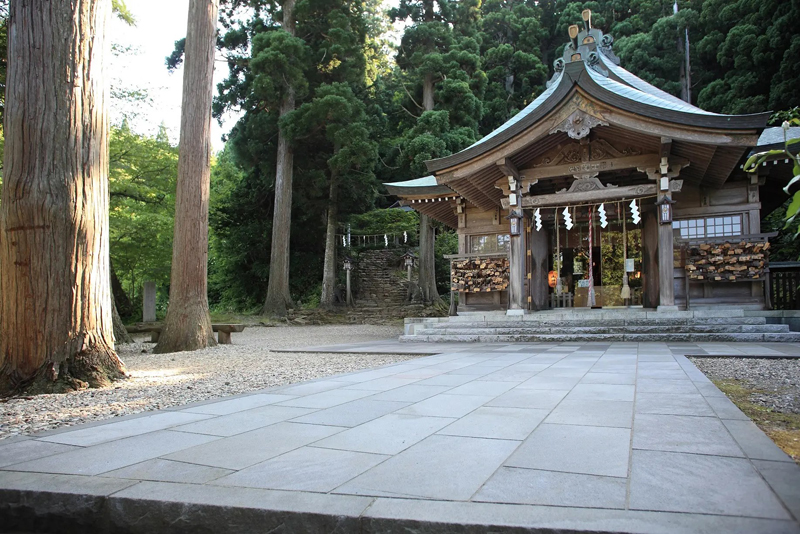
INFORMATON
- Facility name: Shinzan Shrine / Oga Shinzan Tradition Museum / Namahagekan
- Address: 97 Mizukaizawa, Mayama Kitaura, Oga City, Akita Prefecture
- Phone number: 0185-22-5050
- URL: Shinyama Shrine / Oga Shinzan Tradition Museum / Namahage Museum
- access:
- Public transportation: Approximately 40 minutes by Oga Peninsula Ainori taxi “Namahage Shuttle” from Oga Station on the JR Oga Line
- Car: Approximately 40 minutes from Akita Expressway Showa Oga Peninsula IC
GOOGLE MAP
Enjoy the magnificent view of the west coast of the Oga Peninsula from Hachibodai
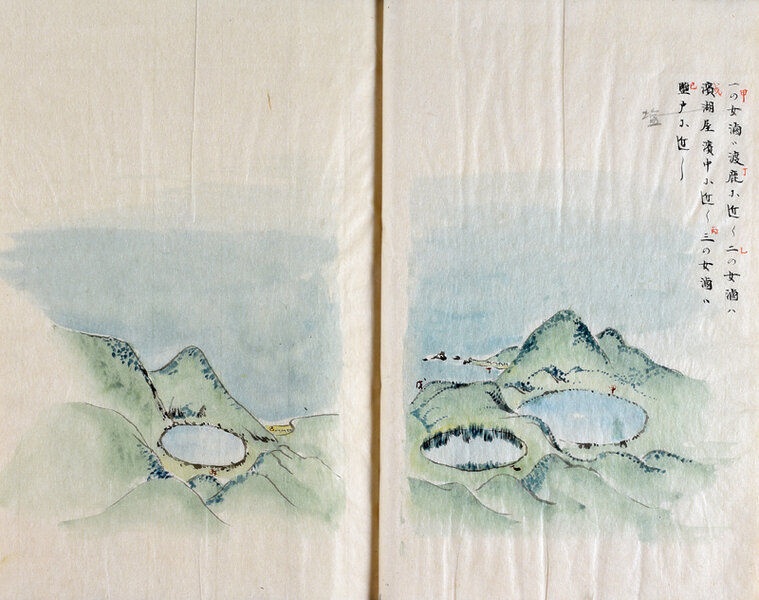
Masumi, who was not feeling well, stayed in the village of Mayama until April 11th. On the 11th, I visited Koiji Temple once, and finally left Mayama on the 12th, heading towards Hatazaki Walk along the mountain path while looking down at port towns such as Kitanoura ( Kitaura/Kitaura, Oga City) and Nomura Nomura Oga Stand/Oga City Togahama Shioya Wazan) offers magnificent views of Ichinome Lagoon (a nationally designated natural monument), Ninome Lagoon , Sannome Lagoon , and Toga no Ura
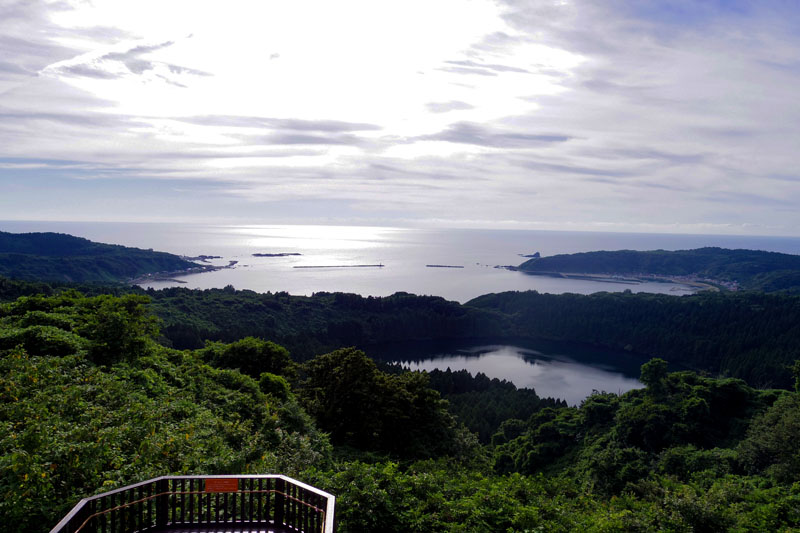
Ninomegata and Toga Bay from Hachibodai ©Akita Prefecture
INFORMATON
- Facility name: Hachibodai
- Location: Togahama Shioya Wazan, Oga City, Akita Prefecture
- Phone number: 0185-24-4700 (Oga City Tourism Association)
- access:
- Public transportation: Approximately 20 minutes by taxi or rental car from JR Oga Station
- Car: Approximately 50 minutes from Akita Expressway Showa Oga Peninsula IC
GOOGLE MAP
After descending from the mountain, Masumi stopped at Kitanoura, which he could see below, on the 14th, stopped at coastal villages on the 16th, and arrived at Yumoto (Kitaura Yumoto, Oga City), where the hot springs are located, on the 22nd. I'll be staying here for a while.
Yumoto is now a popular hot spring area called Oga Onsenkyo, While the hot springs in the Ishiyama area were discovered during limestone mining during the Meiji period, the hot springs in Yumoto were discovered during the Heian period. It seems that it was very popular during the Edo period, and Masumi wrote dark and has a hint of green bean.' “Karakute” means salty, and mokuban is a type of hot spring that contains iron, and is characterized by its greenish color. Currently, hot spring inn, Yumoto , which was founded in the Meiji era, is in operation, and the quality of the spring water is listed as carbonate-containing weak salt spring.
By early May, I had stayed in Yumoto, and my ``Oga no Harukaze'' had ended in a village called Yunojiri, which was close to Yumoto.
Strolling around Hatazaki (Nyudozaki), which was very lonely during the Edo period ("Suzukaze of Oga")
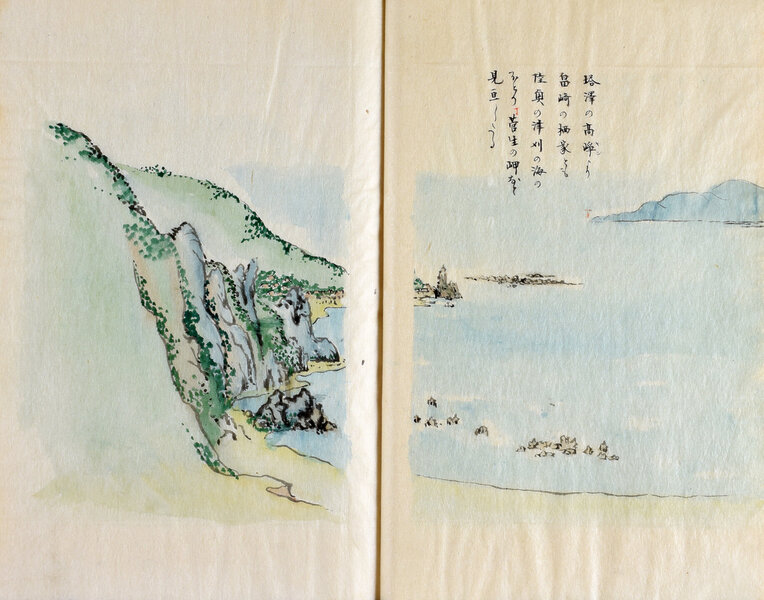
Until mid-June, we will be wandering through villages on the north coast, observing and hearing about local daily life, customs, and events. In late June, we finally leave for the West Coast.
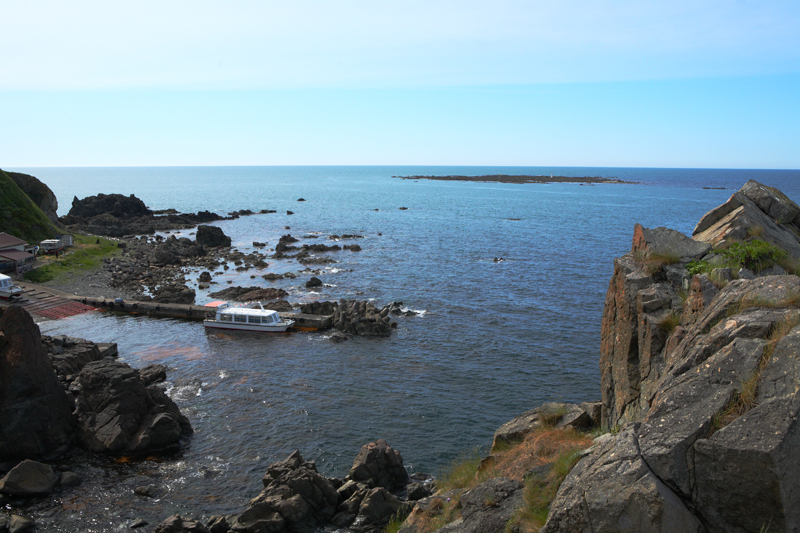
Nyudozaki Konbuura. Mizushima is a flat island floating in the sea ©Oganavi
It was after June 20th that we arrived at our first destination, Hatazaki Nyudozaki was said to have been a "poor place where there was a village where fishermen's houses were built over a towering rock, and rice could not be grown," and the scenery was completely different from the current Oga Peninsula's premier tourist destination. I was there.
On June 23rd, we went to Mizushima Island off the coast of Nyuudozaki and took a walk. It is an island with a flat rock that barely touches the surface of the water, and back then it seems to have been hidden under the water when the wind blew. From the boat returning from Mizushima, you can see the steep rocks of Nyudozaki, including Shishiotoshi.
INFORMATON
- Facility name: Nyudozaki
- Location: Kitaura Nyudozaki, Oga City, Akita Prefecture
- Phone number: 0185-24-4700 (Oga City Tourism Association)
- access:
- Public transportation: Approximately 30 minutes by Namahage shuttle from Oga Station on the JR Oga Line
- Car: Approximately 45 minutes from Akita Expressway Showa Oga Peninsula IC
GOOGLE MAP
Wandering around the very crowded Toga Bay area
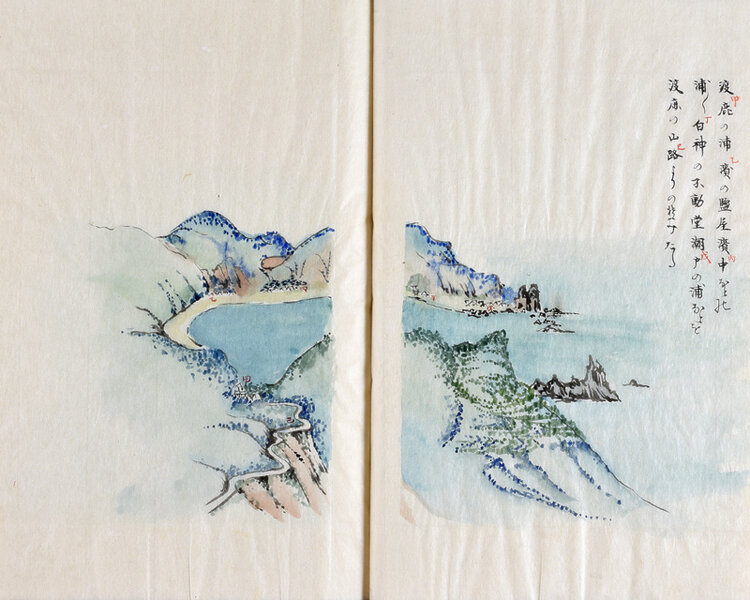
arrived at the port town of Toga no Ura on the west coast along Toga Bay on the 24th Toga Bay used to be a crater and has a beautiful circular shape. As a result, the waves were calm and the port was quite busy, with ``a port where large and small boats gathered and moored, so there were one or two prostitutes.''
Masumi stayed in Toga no Ura for one night, and the next day, he headed south along Toga Bay and Shioto Beach (Toga Shiohama, Oga City), where he stayed overnight. Shioto Beach is the area where Oga Aquarium is currently located. `` Oga no Suzukaze '' ends here, followed by ``Oga no Shimakaze''.
View the complex coastline and strangely shaped rocks of the southwest from a dugout canoe ("Oga no Shimakaze")
The trip begins on July 13th when we depart from Shiotonoura. From Shiotonoura, take a dugout canoe and head south along the west coast of the Oga Peninsula, viewing the strangely shaped rock formations and leaving behind many illustrations.
Beyond Shioto, the terrain continues to be intricate, with capes lined with rocks of various shapes, and numerous fishing ports in the small bays. The boat arrived at our accommodation, a fishing port called Kamo no Ura (Kamoaosa, Oga City) located in the central part of the west coast.
Experience Bon Odori at Kamo Aosa
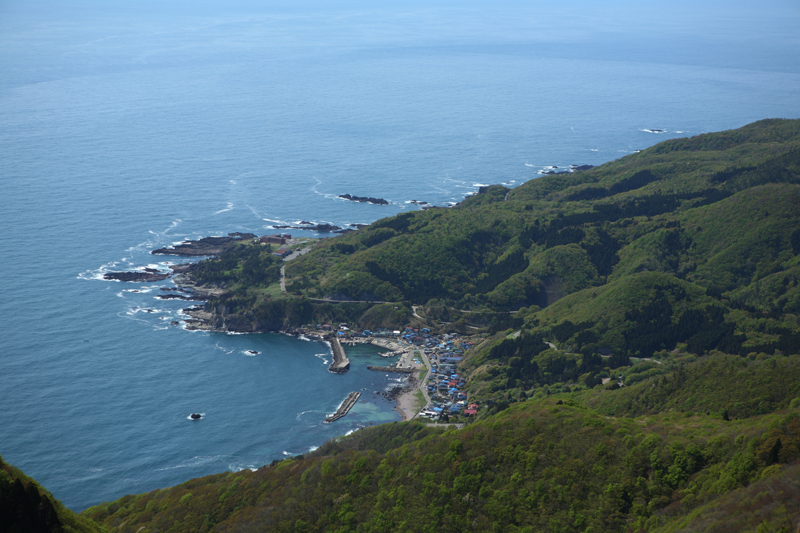
Masumi wrote , `` Kamo/Aosa and villages line up side by side It is divided into the Suna District (formerly Aosuna Village), and even today, private houses are lined up along the rocky shore about 800m north to south. It is said that during the Edo period, residents would sleep on this beach during the summer, with their men, women, and children covering themselves with cloths on the sand after sunset to avoid attracting mosquitoes.
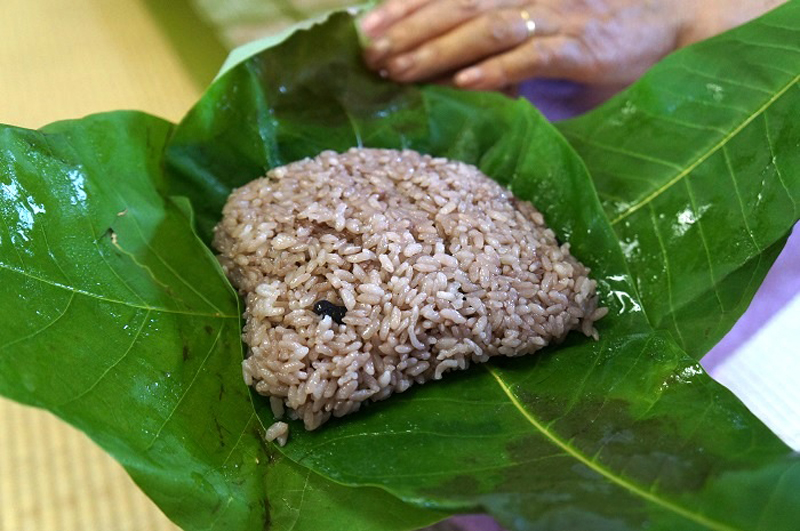
July 14th is Obon (July 13th to 16th/August 13th to 16th according to the solar calendar), and the people of the village start in the morning by boiling fish and vegetables in adzuki bean okowa (adzuki bean rice) and offering it to the Buddhist altar. . In the evening, the Bon dance ``Dadadako'' was held jointly by Kamo and Aosuna, and Masumi also watched and enjoyed the night in Oga.
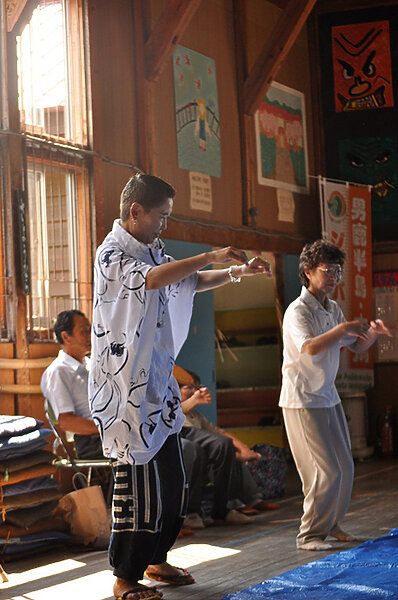
`` Dadadako '' is the unique name for the Kamo Aosa Bon dance, which has been around for a long time, but it ceased to exist around 1998. However, in 2010, it was revived at the suggestion of university students and continues to this day.
Be impressed by the strangely shaped rocks such as Kankane Cave and the Great Pier
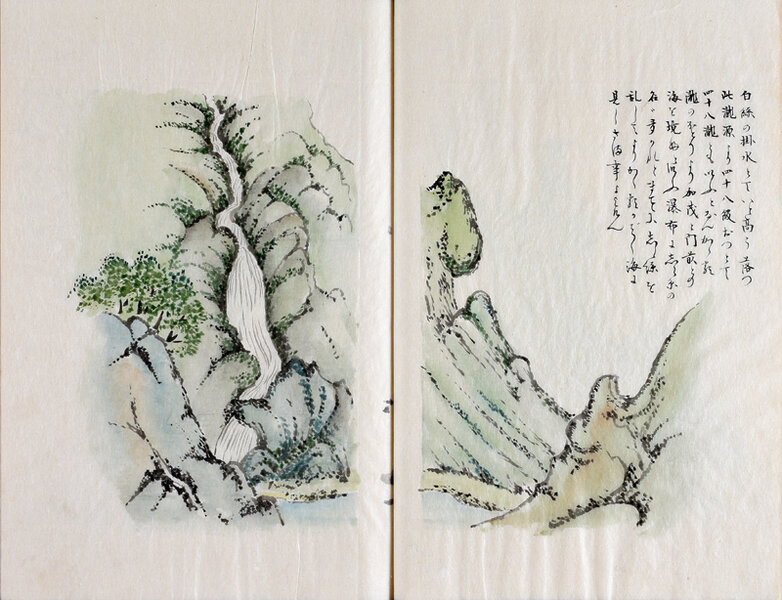
On the 15th, we toured the nearby Shiraito Falls and went inside Kankane Cave [ Kankane Cave ] is a cave formed from rocks on the coast that have been eroded by waves, and when sunlight shines through the hole in the ceiling, it looks very magical.
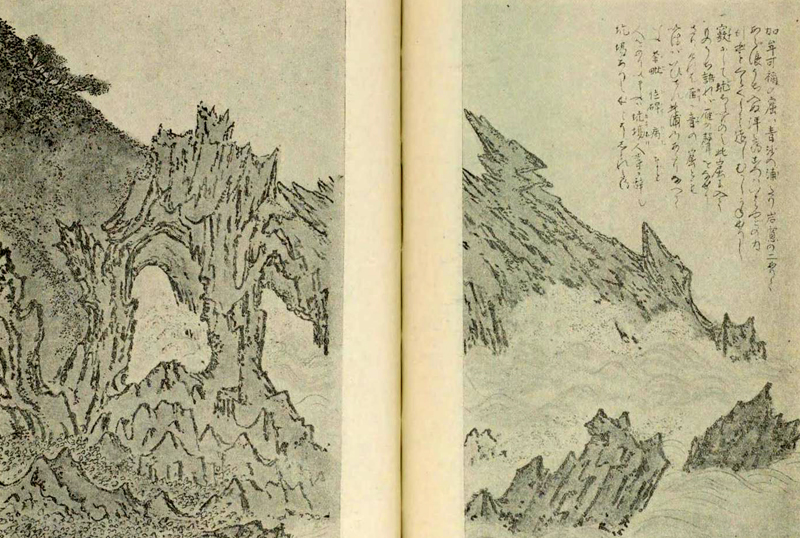
Kankane Cave "Oga no Shimakaze" From the National Diet Library Manuscript Akita Series
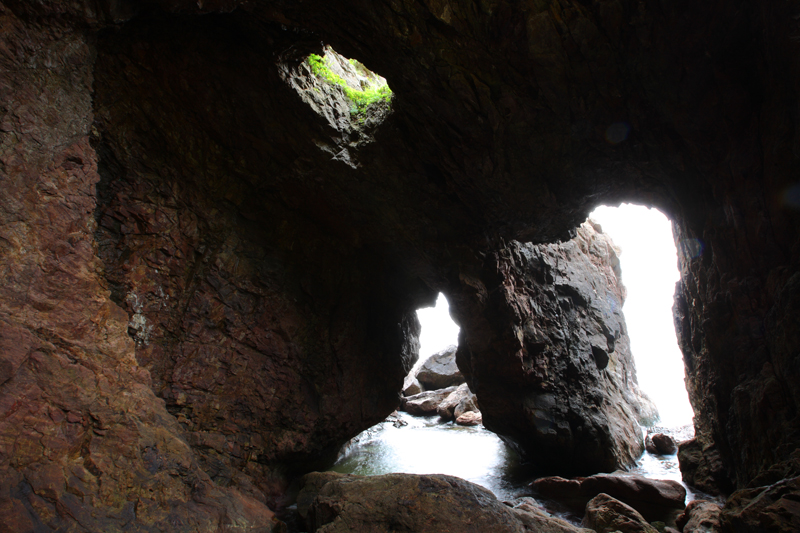
On the 17th, we set out from the port of Kamo and enjoyed the strangely shaped rocks and waterfalls along the coast as far as the southernmost gate (Motoyama Monzen, Funagawa Port, Oga City). Since then, strangely shaped rocks have had various names depending on their shape, Daisankyo Bridge Stage Island , and Kojaku no Iwaya . But there are some familiar names.The boat passes through many small islands and arrives at the gate.
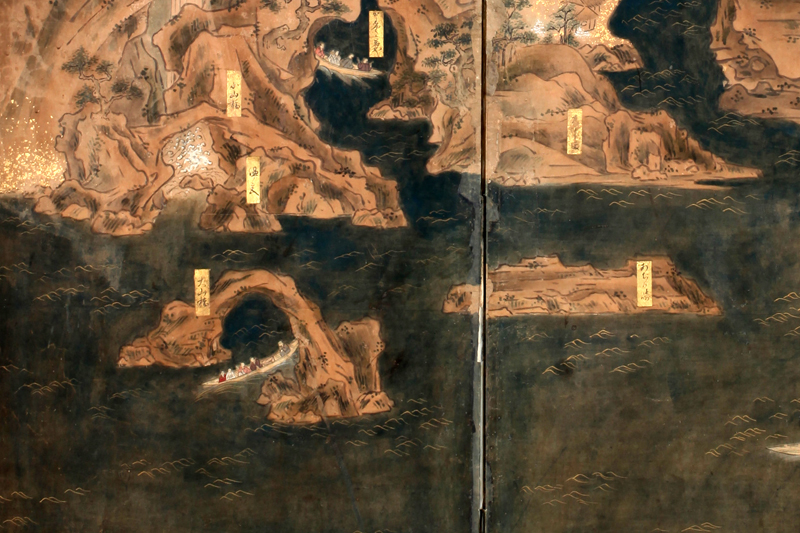
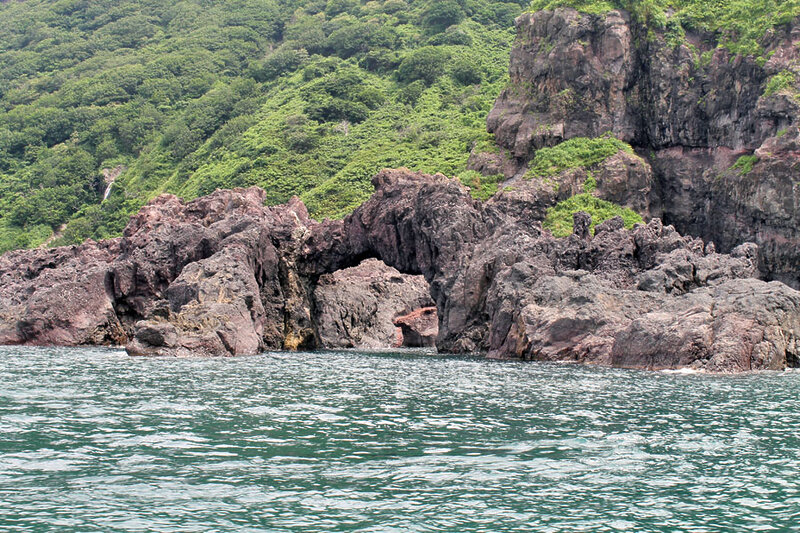
This is Masumi's second visit to the temple, but he will also Nishakuji Temple (Akagami Shrine), which he visited last time (August 27, 1804). Today, the tradition of Nichijo-ji Temple is preserved as Akagami Shrine the 999-step stone staircase , which is said to have been built by a demon in one night, and Gosha-do Hall (a nationally important shrine). It is one of the most popular tourist destinations on the Oga Peninsula.
For sightseeing on the west coast of the Oga Peninsula, we recommend the [ Oga Peninsula Sightseeing Cruise ], where you can see the strangely shaped rocks and mountains of Oga from the sea, just like Masumi Sugae.
INFORMATON
- Facility name: O Pier, Stage Island sightseeing boat terminal (Oga Peninsula sightseeing boat), Akagami Shrine
- Location: Funakawa Port, Oga City, Akita Prefecture, Motoyama Monzen Haragawa
- Phone number: 0185-38-2050
- Operated by: Oga Sightseeing Boat Co., Ltd.
- Price: West Coast Cruise Adults 2,500 yen Children 1,250 yen
- Operation period: Please inquire (closed in winter)
- URL: Oga Peninsula sightseeing boat
- access:
- Railway: Approximately 30 minutes by taxi from Oga Station on the JR Oga Line. Rental cars are available near Oga Station.
- Car: Approximately 70 minutes from Akita Expressway Showa Oga Peninsula IC
GOOGLE MAP
After visiting Nichisakuji Temple (Akagami Shrine), Masumi returns to the town in front of the temple, where ``Oga no Shimakaze'' ends. After that, on July 18th, we started the ``Oga no Kanpu'' trip, which left in front of the gate and walked along the south coast, and during the ``Oga no Kanpu'' trip, we encountered the Oga Earthquake. “Cold Wind of Oga” is a continuation of Part 3 of tracing the Oga Peninsula where Masumi Sugae walked
On the Oga Peninsula where Masumi Sugae walked, there are 90 marker posts and information boards set up to help you take a stroll.
The path that Masumi Sugae walked on the Oga Peninsula has been maintained as the `` Masumi Sugae Path ,'' and there are marker posts at 83 locations that have some connection to the path, and detailed information boards at 8 locations. Please use it as an aid when walking around the Oga Peninsula.
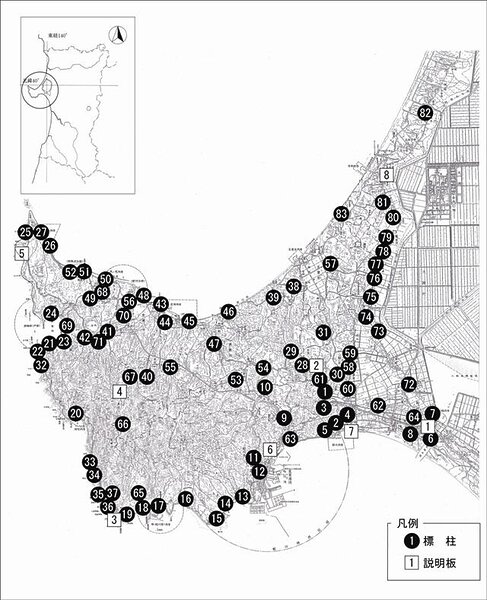
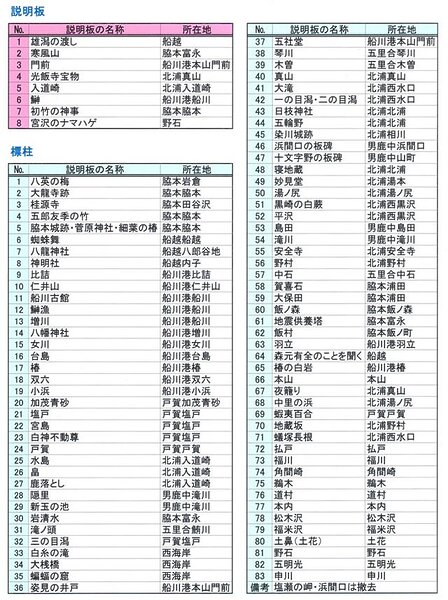


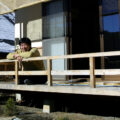





![[Third] Sugae Masumi walked in the Oga Peninsula - Encountered a major earthquake [Akita Prefecture] 1. Oga's Cold Wind - Namahage Prefectural Expo](https://jp.neft.asia/wp-content/uploads/2024/10/7154afaf7fcdc00890442af025f9b4d1-150x150.jpg)
![[First] Sugae Masumi walked in Oga Peninsula - Sankaze Mountain and the Head Mountains of Faith [Akita Prefecture] 1. Group of strange rocks_Akikaze_Archives](https://jp.neft.asia/wp-content/uploads/2024/10/af533a619304de93bb8c3974f774074e-150x150.jpg)
![[Koriyama City, Fukushima Prefecture] Space Park's planetarium is certified by Guinness! Enjoy the world's tallest space theater starry sky and children](https://jp.neft.asia/wp-content/uploads/2018/03/dffa2e7b1a9ce8ec5e557f31f5957d83_s-150x150.jpg)
![Akita Cedar, which has been close to people's lives since ancient times, is a close look at the reasons and secrets [Akita Prefecture] Ninfu Mizusawa Cedar Rare Population Protection Forest (Noshiro City, Akita Prefecture)_Travel Tohoku](https://jp.neft.asia/wp-content/uploads/2025/05/792bcbe7d9fd514753f4deeaca3de33f-150x150.jpg)
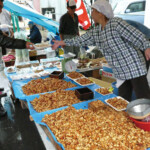
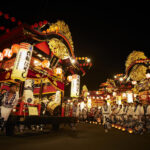
![Let's go see the natural Akita cedars [2] A forest of natural Akita cedars with giant trees over 200 years old Mt. Nanaza](https://jp.neft.asia/wp-content/uploads/2025/08/2e1cab44ce484b377d4a0b2675da2274-150x150.jpg)
![[The Mystery of Kamakura] Are Kamakura, a winter feature of Akita Prefecture, connected to the Kamakura Shogunate? Yokote 4_Travel Tohoku 1000](https://jp.neft.asia/wp-content/uploads/2025/08/a2674c8c7497fa159899e9b2a761c38f-150x150.jpg)

